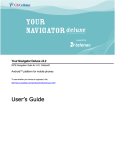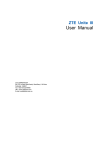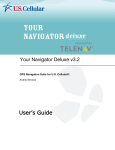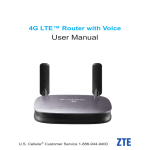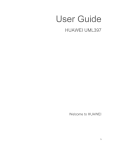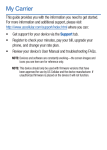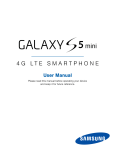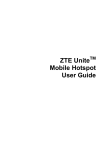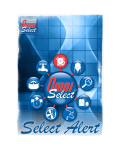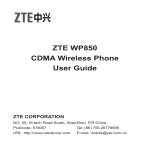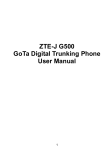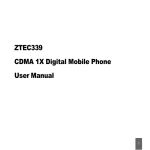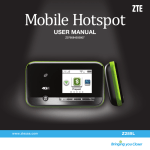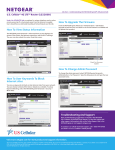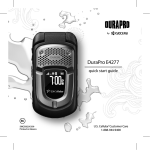Download User Manual - US Cellular
Transcript
LEGAL INFORMATION Copyright © 2014 ZTE CORPORATION. All rights reserved. No part of this publication may be excerpted, reproduced, translated or utilized in any form or by any means, electronic or mechanical, including photocopying and microfilm, without the prior written permission of ZTE Corporation. The manual is published by ZTE Corporation. We reserve the right to make modifications on print errors or update specifications without prior notice. 4G LTE™ is not available in all areas. See uscellular.com/4G for complete coverage details. 4G LTE™ service provided through King Street Wireless, a partner of U.S. Cellular. LTE™ is a trademark of ETSI. Version No. : 1.0 Edition Time: 1.2014 NOTE: Do not use the device in an enclosed environment or where heat dissipation is poor. Prolonged work in such space may cause excessive heat and raise ambient temperature, which may lead to automatic shutdown of the device for your safety. In the case of such event, cool the device in a well-ventilated place before turning on for normal use. Contents Getting Started .................................................................................................................. 1 Introduction ................................................................................................................... 1 Outline and Parts ........................................................................................................... 1 Indicators ....................................................................................................................... 1 Inserting the SIM Card and Battery .............................................................................. 2 Inserting the microSDHC Card ..................................................................................... 3 Powering On/Off Your Device ..................................................................................... 3 Sleep Mode ................................................................................................................... 4 Charging Your Device .................................................................................................. 4 Internet Access .................................................................................................................. 4 Configuring Your PC .................................................................................................... 5 Connecting to Your Device........................................................................................... 6 Accessing the Internet ................................................................................................... 8 Disconnecting from the Internet ................................................................................... 8 Navigating the Device ....................................................................................................... 8 Resetting Your ZTE UniteTM II ...................................................................................... 8 Device Info .................................................................................................................... 9 Connection Info............................................................................................................. 9 Connected Device ......................................................................................................... 9 Settings .......................................................................................................................... 9 WPS ............................................................................................................................ 10 Web User Interface Configuration .................................................................................. 10 Accessing the Configuration Page .............................................................................. 10 Login ........................................................................................................................... 10 Settings ............................................................................................................................ 11 Quick Settings ............................................................................................................. 11 Network Settings ......................................................................................................... 14 Wi-Fi Settings ............................................................................................................. 17 Device Settings ........................................................................................................... 20 Firewall ....................................................................................................................... 22 Router Settings ............................................................................................................ 26 Dial *228 ..................................................................................................................... 26 Information...................................................................................................................... 27 Device Information ..................................................................................................... 27 Statistics ...................................................................................................................... 27 Data Limit Settings ..................................................................................................... 27 File Sharing ..................................................................................................................... 28 Sharing SD Card via USB Cable ................................................................................ 28 Sharing SD Card via Web Browser ............................................................................ 28 Messages ......................................................................................................................... 29 Operating Messages in Native .................................................................................... 29 Operating Messages in SIM Card ............................................................................... 30 Configuring Messages................................................................................................. 30 Warning and Notice ........................................................................................................ 31 To the Owner .............................................................................................................. 31 Using Your Device...................................................................................................... 31 Using Battery .............................................................................................................. 31 Limited Warranty ........................................................................................................ 32 Limitation of Liability................................................................................................. 32 Radio Frequency (RF) Energy (Only for US Market) ................................................ 32 FCC Compliance (Only for U.S. Market) ................................................................... 33 Disposal of Your Old Appliance ................................................................................. 33 Troubleshooting .............................................................................................................. 34 ZTE UniteTM II User Manual Getting Started Introduction ZTE UniteTM II is a 4G LTE™ mobile hotspot device, using a 4G LTE™ network. The client devices can connect to ZTE UniteTM II via Wi-Fi. The device supports data services, enabling you to communicate anytime and anywhere. Outline and Parts The following figure shows the appearance of the device. It is only for your reference. The actual device may be different. 1.Power Button Press and hold the Power button to switch on/off the device. 2.Charger/USB port Charge your device. 3.OK Key Enter or select an item. 4.Left Key Check the on-screen menu from right to left. 5.Right Key Check the on-screen menu from left to right. 6.Back Key Go back to the previous screen. 7. LCD Screen It indicates the signal type, signal strength, battery, Wi-Fi, etc. 8.microSDHC card slot It is where you insert the microSDHC card. Indicators When the device is powered on, the following icons will appear on the LCD screen, with the corresponding indicators listed in the table below: Confidential and Proprietary Information of ZTE CORPORATION 1 ZTE UniteTM II User Manual Icon Indication Icon Indication Network signal strength. Roaming network indication. Network type. 1X/3G/4G LTE™ icons will appear on the LCD screen according to the connected network. The device is connected to the Internet. Connected to the Internet manually. There are new messages or unread messages. Wi-Fi Status and number of the connected users. The message inbox is full. Battery is low. Show and check the device information. Battery power indication. Show and check the data connection information. The battery is full. Show and check the clients connected to your device. Set the WPS function. Set your device. Inserting the SIM Card and Battery 1. Remove the back cover. 2. Insert the SIM card into the SIM card slot. 3. Insert the battery as shown with the contacts located against the metal springs, and press the battery down into the case. 2 Confidential and Proprietary Information of ZTE CORPORATION ZTE UniteTM II User Manual 4. Close the back cover. Inserting the microSDHC Card NOTE: MicroSDHC logo is a trademark of SD-3C, LLC. MicroSDHC card is sold separately. 1. Pull the microSDHC card cover out of the card slot. NOTE: Do not remove with excessive force. 2. Insert the microSDHC card into the microSDHC card slot, as shown below. You will hear a click when the microSDHC card locks in place. 3. Close the microSDHC card cover. Powering On/Off Your Device Press and hold the Power button to switch on/off the device. Confidential and Proprietary Information of ZTE CORPORATION 3 ZTE UniteTM II User Manual NOTE: The device is powered on when the LCD screen lights up. Sleep Mode When using battery supply and no users are connected, the device will enter sleep mode after a specified time. In the sleep mode, the Wi-Fi function will be disabled. Press the Power button to wake up the device and enable the Wi-Fi function, and the LCD screen will be turned on. NOTE: Only the Wi-Fi function will be disabled when the device is connected via USB and no user is connected. Press the Power button to enable the Wi-Fi function. Charging Your Device You can charge your device by using the USB cable or adapter. Use the USB cable to connect your device and PC directly. Use the adapter and USB cable to connect the wall outlet and your device. NOTE: Do not use excessive force to insert the plug. Internet Access You can connect up to 10 Wi-Fi enabled devices at one time including computers, tablets, smartphones and more. 4 Confidential and Proprietary Information of ZTE CORPORATION ZTE UniteTM II User Manual Configuring Your PC Follow the steps for Windows XP to configure the Wireless Internet Protocol for your connection. NOTE: Wireless Network Connection is used for Wi-Fi connection. 1. Right-click My Network Places and then select Properties. 2. Right-click the Wireless Network Connection, and then select Properties. 3. Select Internet Protocol (TCP/IP), and then click Properties. Confidential and Proprietary Information of ZTE CORPORATION 5 ZTE UniteTM II User Manual 4. Select these two items, and then click OK to finish the configuration. Connecting to Your Device 1. Power on your device. It will take 1-2 minutes to power up. 2. Use your Wi-Fi application on the client to search for available wireless networks. 6 Confidential and Proprietary Information of ZTE CORPORATION ZTE UniteTM II User Manual 3. Select the SSID of your device, and then click Connect. NOTE: Please check the label on your device to get the default SSID. 4. Input the password, and then click Connect. NOTE: You may need to input the password for Wi-Fi connection. Please check the label on your device to get the default password. 5. Your client will connect to the Unite II. Confidential and Proprietary Information of ZTE CORPORATION 7 ZTE UniteTM II User Manual Accessing the Internet 1. Switch on the device. 2. Connect the client to your device. 3. After the client is connected to your device successfully, you can access the Internet. Disconnecting from the Internet Log into the Web User Interface Configuration page, click the Disconnect button at the Home page. NOTE: Powering off the device can also terminate the Internet connection. Navigating the Device Press and hold the Power button to turn on the ZTE UniteTM II. The screen lights up to indicate the device has turned on and the following icons will appear after initialization. Resetting Your ZTE UniteTM II Simply press and hold the Reset button on right side of the device bottom surface for 3 seconds to restore 8 Confidential and Proprietary Information of ZTE CORPORATION ZTE UniteTM II User Manual your ZTE UniteTM II to the factory default settings, as shown below. Device Info Select the device Info icon and press the OK Key to check the WAN information. Use the Left and Right key to view the following information: Network Name (SSID): Displays the default SSID. Wi-Fi Password: Displays the default Wi-Fi password. Web portal Login: Displays the login URL of the web user interface. Admin Password: Displays the default login password of the web user interface. Mobile Number: Displays your mobile number. MEID (H) / IMEI (D): Displays the MEID (H) / IMEI (D). Firmware Version: Displays the firmware version. Hardware Version: Displays the hardware version. Connection Info Select the connection info icon and press the OK Key to check the connection information. Connected Device Select the connected device icon connected to your device. and press the OK Key to check the information of the devices Settings Select settings icon and press the OK Key to check the settings. Use the Left and Right key to scroll to the desired menu. Wi-Fi Settings: Enable or disable Wi-Fi function. Network Select: Select the network type. Software Update: Update the software. Sound Alert: Turn on or off the sound alert. It is on by default, so you will hear an alert when there is one or more device connected to your ZTE UniteTM II. Screen Timeout: Set time for screen timeout. Dial *228: Active your SIM card manually in 1X network. Confidential and Proprietary Information of ZTE CORPORATION 9 ZTE UniteTM II User Manual Messages Settings: Turn on or off the Receive Messages during power up. NOTE: By disabling the Text Message feature you will not receive any incoming messages when the device powers up in a 4G LTE™ network. You will still receive Text Messages in 3G networks. To receive messages when the device powers on please enable the Text Messages feature. WPS Select the WPS icon and press the OK Key to launch the Wi-Fi Protection Setup. Web User Interface Configuration Accessing the Configuration Page 1. 2. Make sure there is a connection between your device and the client. Launch the Internet browser and enter http://192.168.1.1 or http://uscc.hotspot in the address bar. NOTE: It is recommended that you use IE (7.0 or later), Firefox (15.0 or later), Opera (10.0 or later), Safari (4.0 or later), Google Chrome (10.0 or later). 3. The login page appears as follows. The following figure is only for your reference. Login On the Web User Interface Configuration page, input the password (please select Device Info on the LCD screen to get the default password). Click Login to log in the device. The Web User Interface is divided into three parts. Index: Shows the configuration list for your device Content: Shows the detailed configuration. 10 Confidential and Proprietary Information of ZTE CORPORATION ZTE UniteTM II User Manual System Information: Shows the system status and different kinds of tips. Battery indicator Signal strength Internet status : Shows the battery level, 4 stages from none to high : Shows the network signal intensity, 5 stages from none . to strong . : Connected to the Internet. : Disconnected from the Internet. Wi-Fi strength : Wi-Fi status and number of the connected users. The maximum number is 10. Settings • Do not modify any settings unless instructed by your service provider. • Please disconnect the device from the network before changing the settings. Quick Settings 1. In the main interface click Settings > Quick Settings. 2. Read the guide carefully, and then click Next. 3. Set PPP Profile Configuration in the following figure and then click Next. Confidential and Proprietary Information of ZTE CORPORATION 11 ZTE UniteTM II User Manual 4. Set PPP Authentication in the following figure and then click Next. 5. Set SSID Configuration in the following figure and then click Next. 12 Confidential and Proprietary Information of ZTE CORPORATION ZTE UniteTM II User Manual Service Set Identifier (SSID) is used to uniquely identify your WLAN. If you enable Broadcast Network Name (SSID), the gateway will broadcast the SSID, and other devices can detect and connect to it. 6. Set Security Configuration in the following figure and then click Next. Encryption will keep your traffic from being unauthorized monitored and accessed, select one encryption mode from the list, and then set key and/or algorithm for it. 7. Show the configuration in the following figure: Confidential and Proprietary Information of ZTE CORPORATION 13 ZTE UniteTM II User Manual Make sure that all the parameters shown in the figure are correct, and then click Apply. Network Settings Dial-up Settings Select Settings > Network Settings > Dial-up Settings. The Dial-up Settings page is shown in the following figure. You can set the WAN connection mode here. The default mode is Automatic. Network Selection Select Settings > Network Settings > Network Selection. The Network Selection page is shown in the following figure. 14 Confidential and Proprietary Information of ZTE CORPORATION ZTE UniteTM II User Manual • LTE/CDMA: Device connects to LTE/CDMA network. • 3G Auto: Device connects to 3G network. Click Apply to confirm your configuration. NOTE: To change the current settings, please disconnect from the network first. APN Setting Select Settings > Network Settings > APN Setting. The APN parameters are shown in the following figure. • Click Set as default to set current profile as the default profile. Confidential and Proprietary Information of ZTE CORPORATION 15 ZTE UniteTM II User Manual • Click Add New to access the following figure: Enter the related parameters (please see following table), and then click Apply to add a new profile. Parameter Function Mode If a fixed APN is provided by your service provider, select Manual APN. Otherwise, please select Auto APN, and the device will automatically obtain parameters. Profile Selection Choose one profile from the list. PDP Type Choose a PDP type from the drop-down list, IPv4 / IPv6 / IPv4&IPv6. Profile Name Type the profile name. APN Type the APN string. DNS Mode Set DNS mode. Authentication Password Authentication Protocol (PAP) provides a simple method without encryption for the peer to establish its identity using a 2-way handshake. Challenge-Handshake Authentication Protocol (CHAP) is used to periodically verify the identity of the peer using a 3-way handshake. 16 Confidential and Proprietary Information of ZTE CORPORATION ZTE UniteTM II User Manual User Name User name is used to obtain authentication from the ISP when the connection is established. Password Password is used to obtain authentication from the ISP when the connection is established. Wi-Fi Settings Basic Select Settings > Wi-Fi Settings > Basic Settings, the wireless network basic parameters are shown in the following figure: Multi SSID Switch: Enable or disable this function. Two SSIDs can be used at the same time. Network Name (SSID): Service Set Identifier (SSID). Enter a string less than 32 characters as the name for your wireless local area network (WLAN). Broadcast Network Name (SSID): Disable or Enable (Default) this function. If Enable is selected, the device broadcasts the SSID, and other devices can search and connect to it. When you select Disable, other devices cannot see the SSID. If you want someone to connect, you need to tell them the SSID, and let them setup manually. Confidential and Proprietary Information of ZTE CORPORATION 17 ZTE UniteTM II User Manual AP Isolation: Enable or disable this function. If Enable is selected, the wireless devices connected to your device will be unable to communicate with each other. Security Mode: The security modes are described below: Mode Description OPEN You can authenticate successfully with a SSID, whether it is valid or empty. WPA2(AES)-PSK It is the securer version of WPA with implementation of the 802.11i standard. WPA-PSK/WPA2-PSK Apply both the WPA-PSK and WPA2-PSK scheme. Wi-Fi Password: Enter the password manually. LTE Max Station Number: Choose the maximum number of the stations which connect to the 4G LTE™ network simultaneously. CDMA Max Station Number: Choose the maximum number of the stations which connect to the CDMA network simultaneously. Click Apply to confirm your configuration. Advanced Settings Select Settings > Wi-Fi Settings > Advanced Settings, the parameters are shown in the following figure: Band Selection: Select a band from the drop-down list. Network Mode: If all of the wireless devices connect with this device in the same transmission mode, the performance will be improved when you choose the appropriate wireless mode. Channel Bandwidth: Select a channel bandwidth from the drop-down list. Country/Region Code: Select the right country code. When using the device internationally, please change the country/region code. 18 Confidential and Proprietary Information of ZTE CORPORATION ZTE UniteTM II User Manual Frequency (Channel): Select the appropriate channel to optimize the performance and coverage of your wireless network. Black List Select Setting > Wi-Fi Settings > Black List, the Black List configuration is shown in the following figure: If you select Enable, the black list page will appear. All the clients connected to your device are shown in the Device Information area. Click Block behind the device you want to block and then it will be added to the black list. Click Delete to delete the device from the black list. WPS You can enable Wi-Fi Protected Setup (WPS) by PIN (PIN Code) or PBC (push-button) mode on this page. If your client device supports WPS, there’s no need to enter password manually when WPS is available. Select Settings > Wi-Fi Settings > WPS, the WPS configuration is shown in the following figure: Confidential and Proprietary Information of ZTE CORPORATION 19 ZTE UniteTM II User Manual SSID: Select the wireless network name that you want to connect to. PIN:Enter the PIN that is generated by wireless access client. PBC: 1. Select the PBC mode in the client WPS UI; 2. Select PBC mode in the WPS page of the device and submit; 3. Select the WPS icon on the device screen and press the OK Key to active your device’s WPS. 4. Please press the "next" button on the Client WPS UI. After a few seconds the client can access the WLAN, and the result will be shown in the Client WPS UI. Device Settings Account Management Select Settings > Device Settings > Account Management, and the administrator settings information is shown in the following figure: You can change the administrator’s password. Click Apply to confirm your configuration. Reset Select Settings > Device Settings > Reset, click Reset to set all the settings to their factory default values, and then the device will restart automatically. 20 Confidential and Proprietary Information of ZTE CORPORATION ZTE UniteTM II User Manual Restart Select Settings > Device Settings > Restart. Click Restart to restart the device. Power Save Select Settings > Device Settings > Power Save. You can set Wi-Fi performance and Wi-Fi sleep to save power. Wi-Fi Performance Settings Short Wi-Fi Range: Increases battery life. Medium Wi-Fi Range: Intermediates battery life and Wi-Fi range. Long Wi-Fi Range: Extends coverage of mobile hotspot, which will decrease battery life. Wi-Fi Sleep Settings Sleep Time: Select a time from the drop-down list. When there’s no Wi-Fi connection in the specified time, Wi-Fi will be unavailable and the system will turn to sleep mode for power-saving. Confidential and Proprietary Information of ZTE CORPORATION 21 ZTE UniteTM II User Manual Firewall You may set up firewall rules to protect your network from virus, worm and malicious activity on the Internet. NOTE: You can set the maximum 10 filtering items for MAC/IP/Port Filtering and Port Forwarding. Port Filtering Select Settings > Firewall > Port Filtering. The MAC/IP/Port Filtering is shown in the following figure: If you select Enable, the filter settings will appear as shown below: 22 Confidential and Proprietary Information of ZTE CORPORATION ZTE UniteTM II User Manual Default Policy: Set how to handle the packet if none of the rules match. IP Settings: Select IPv4 or IPv6. MAC Address: Set the MAC address that will be filtered. Source IP Address: Set the source IP address that will be filtered. Destination IP Address: Set the destination IP address that will be filtered. Protocol: Set which protocol will be used for filtering. Action: Set how to handle the packet if it matches with the rule. Comment: Type comment for the filter settings. Confidential and Proprietary Information of ZTE CORPORATION 23 ZTE UniteTM II User Manual Click Apply to confirm your configuration. Click Delete to delete the rule which you selected. To add a new rule: 1. Select Enable in the Port Filtering area. 2. Click Apply. 3. Input the detail information in the MAC/IP/Port Filtering Settings area. 4. Click Apply in the MAC/IP/Port Filtering Settings area. Port Mapping You can set up Port Mapping to enable external computers to access www, FTP or other services provided by LAN. Select Settings > Firewall > Port Mapping and the Port Mapping page is shown in the following figure: If you select Enable, the Port Mapping Settings will appear: 24 Confidential and Proprietary Information of ZTE CORPORATION ZTE UniteTM II User Manual • Source Port: Set the source port of the computer that provides services. • Destination IP Address: Specify a computer located at LAN to provide services. • Destination Port: Set the destination port of the computer that provides services. • Protocol: Set which protocol will be applied by services. • Comment: Type comment for the port mapping settings. Click Apply to add a new rule. Click Delete to delete the rule which you selected. UPnP Universal Plug Play (UPnP) is a set of networking protocols that allows network devices, such as PC, printers, Internet gateways, Wi-Fi access points and mobile devices, to seamlessly discover each other’s presence on the network and establish functional network services for data sharing, communications, and entertainment. Select Settings > Firewall > UPnP and the UPnP settings page is shown in the following figure: Check Enable and click Apply to enable the function. DMZ The DMZ host feature allows one local host be exposed to the Internet for a special-purpose service such as Internet gaming. Select Settings > Firewall > DMZ and the following page will appear: If you select Enable, the DMZ Settings will appear: Confidential and Proprietary Information of ZTE CORPORATION 25 ZTE UniteTM II User Manual Enter the IP address of the device you want to communicate with the Internet, and then click Apply to save the settings. Router Settings Select Settings > Router Settings and the router information are shown in the following figure: • IP Address: IP address for LAN interface. • Subnet Mask: Subnet mask for the IP address. • DHCP Server: Enable or disable DHCP Server function. • DHCP IP Pool: Allocate begin and end IP address for IP pool. • DHCP Lease Time: Define how long the leased IP address will be expired. The new IP address will be relocated after the IP address is expired. Click Apply to confirm your configuration. Dial *228 This function allows you to active your SIM card manually in a 1X network. Select Dial *228 and the following page will appear. Click Dial *228 to active your SIM card. 26 Confidential and Proprietary Information of ZTE CORPORATION ZTE UniteTM II User Manual Information This function allows you to view system information. Device Information Select Information > Device Information and then you can view the device information. Statistics Select Information > Statistics and then the statistics information is shown in the following figure: Click Clear to clear the information. NOTE: Data usage is an estimate. Please see uscellular.com/myaccount for more information. Data Limit Settings Select Information > Data Limit Settings and then the following page is shown. If you select Enable, the Data Limit Settings will appear: Confidential and Proprietary Information of ZTE CORPORATION 27 ZTE UniteTM II User Manual Limit by: Select a way to limit the data use, by data or time. Monthly: Set data limit for a month. You can select unit from the drop-down list. Remind me: Set a percentage to remind you when the data/time reaches the specified percentage. File Sharing File sharing allows you to share the files in a SD card via USB cable or web browser. Sharing microSDHC Card via USB Cable 1. 2. 3. Select File Sharing to set the sharing mode on the above page. The default mode is USB. Connect the device to PC/Tablet via USB cable. Go to My Computer of your PC/Tablet to access all files in microSDHC card. NOTE: You can access microSDHC card via USB cable only in USB mode. The web page of sharing microSDHC card will be disabled. Sharing microSDHC Card via Web Browser Select File Sharing and then the microSDHC card page is shown as the following figure. 28 Confidential and Proprietary Information of ZTE CORPORATION ZTE UniteTM II User Manual 1. 2. 3. 4. 5. 6. Check Full Share mode. Check Enable to enable share settings. Set File to Share and Access Type. Click Apply to save the settings. Launch the Internet browser on your PC/Tablet/Smart phone connected to the device via Wi-Fi and enter http://192.168.1.1 in the address bar. Click View SD Card on the login window to access the files in microSDHC card. Messages This function allows you to receive messages. Operating Messages in Native You can check the messages saved in your device. Device Messaging Select Messages > Device Messaging to access the following figure: Confidential and Proprietary Information of ZTE CORPORATION 29 ZTE UniteTM II User Manual All the received messages saved in your device will be displayed here. Click Delete to delete the selected messages. Click Refresh to refresh manually. Operating Messages in SIM Card You can check the messages saved in your SIM card. SIM Messaging Select Messages > SIM Messaging to access the following figure: All the received messages saved in the SIM card will be displayed here. Click Delete to delete the selected messages. Check the checkbox next to Delete to select all the messages in SIM card and then click Delete to delete them. Configuring Messages Select Messages > Messaging Settings to access the following figure: By disabling this SMS feature, you will not receive any incoming messages when the device powers up in a 4G LTE™ network but you will still receive SMS in 3G networks. To receive messages when the device powers on, please enable this feature. 30 Confidential and Proprietary Information of ZTE CORPORATION ZTE UniteTM II User Manual Warning and Notice To the Owner • Some electronic devices are susceptible to electromagnetic interference sent by your device if inadequately shielded, such as the electronic system of vehicles. Please consult the manufacturer of your device before using if necessary. • Operating your device may interfere with medical devices like hearing aids and pacemakers. Please always keep them more than 20 centimeters away from such medical devices when they are turned on. Turn your device off if necessary. Consult a physician or the manufacturer of the medical device before using your device. • Be aware of the usage limitation when using your device at places such as oil warehouses or chemical factories, where there are explosive gases or explosive products being processed. Turn off your device if required. • The use of electronic transmitting devices is forbidden in aircrafts, at petrol stations and in hospitals. Please observe and obey all warning signs and switch off your device in these conditions. • Do not touch the inner antenna area if not necessary. Otherwise it will affect your device’s performance. • Store your device out of the reach of little children. Your device may cause injury if used as a toy. • Do not touch the metallic parts of your device so as to avoid a burn, when your device is working. Using Your Device • Please use original accessories or accessories that are authorized. Using any unauthorized accessories may affect your device’s performance, and violate related national regulations about telecom terminals. • Avoid using your device near or inside metallic structures or establishments that can emit electromagnetic waves. Otherwise it may influence signal reception. • Your device is not waterproof. Please keep it dry and store in a shady and cool place. • Do not use your device immediately after a sudden temperature change. In such case, it will produce dew inside and outside your device, so don’t use it until it becomes dry. • Handle your device carefully. Do not drop, bend or strike it. Otherwise your device will be damaged. • No dismantling by non-professionals and only qualified technicians can undertake repair work. • Operating temperature range of 0℃ ~ +35℃ and humidity range of 5% ~ 95% are recommended. Using Battery • Do not short-circuit the battery, as this can cause excessive heat and fire. • Do not store battery in hot areas or dispose of it in a fire to avoid explosion. • Do not disassemble or modify the battery. • When not using the battery for a long period, remove it from your device and store it in a cool dry place. • Never use any charger or battery damaged or worn out. • Return the worn-out battery to the provider or put it in the appointed recycle place. Do not dispose of the battery in the trash. Confidential and Proprietary Information of ZTE CORPORATION 31 ZTE UniteTM II User Manual WARNING! If the battery is broken, keep away from it. If it taints your skin, wash your skin with abundant fresh water and ask doctor for help if necessary. Limited Warranty • This warranty does not apply to defects or errors in the Product caused by: i. Reasonable abrasion. ii. End User’s failure to follow ZTE’s installation, operation or maintenance instructions or procedures. iii. End User’s mishandling, misuse, negligence, or improper installation, disassembly, storage, servicing or operation of the Product. iv. Modifications or repairs not made by ZTE or a ZTE-certified individual. v. Power failures, surges, fire, flood, accidents, and actions of third parties or other events outside ZTE’s reasonable control. vi. Usage of third-party products, or usage in conjunction with third-party products provided that such defects are due to the combined usage. vii. Any other cause beyond the range of normal usage intended for the Product. End User shall have no right to reject or return the Product, or receive a refund for the Product from ZTE under the above-mentioned situations. • This warranty is End User’s sole remedy and ZTE’s sole liability for defective or nonconforming items, and is in lieu of all other warranties, expressed, implied or statutory, including but not limited to the implied warranties of merchantability and fitness for a particular purpose, unless otherwise required under the mandatory provisions of the law. Limitation of Liability ZTE shall not be liable for any loss of profits or indirect, special, incidental or consequential damages resulting from or arising out of or in connection with using of this product, whether or not ZTE had been advised, knew or should have known of the possibility of such damages, including, but not limited to lost profits, interruption of business, cost of capital, cost of substitute facilities or product, or any downtime cost. Radio Frequency (RF) Energy (Only for US Market) This model device meets the government’s requirements for exposure to radio waves. This device is designed and manufactured not to exceed the emission limits for exposure to radio frequency (RF) energy set by the Federal Communications Commission of the U.S. Government: The exposure standard for wireless devices employs a unit of measurement known as the Specific Absorption Rate, or SAR. The SAR limit set by the FCC is 1.6 W/kg. *Tests for SAR are conducted using standard operating positions accepted by the FCC with the device transmitting at its highest certified power level in all tested frequency bands. Although the SAR is determined at the highest certified power level, the actual SAR level of the device while operating can be well below the maximum value. This is because the device is designed to operate at multiple power levels so as to use only the position required to reach the network. In general, the closer you are to a wireless base station, the lower the power output. The highest SAR value for the model device as reported to the FCC when worn on the body, as described in this user guide, is 1.26 W/kg (Body-worn measurements differ among device models, depending upon available enhancements and FCC requirements.) 32 Confidential and Proprietary Information of ZTE CORPORATION ZTE UniteTM II User Manual While there may be differences between the SAR levels of various devices and at various positions, they all meet the government requirement. The FCC has granted an Equipment Authorization for this model device with all reported SAR levels evaluated as in compliance with the FCC RF exposure guidelines. SAR information on this model device is on file with the FCC and can be found under the Display Grant section of http://www.fcc.gov/oet/ea/fccid/ after searching on FCC ID: SRQ-MF96U. FCC Compliance (Only for U.S. Market) This device complies with part 15 of the FCC Rules. Operation is subject to the following two conditions: (1) This device may not cause harmful interference, and (2) this device must accept any interference received, including interference that may cause undesired operation. Caution: Changes or modifications not expressly approved by the manufacturer could void the user’s authority to operate the equipment. NOTE: This equipment has been tested and found to comply with the limits for a Class B digital device, pursuant to part 15 of the FCC Rules. These limits are designed to provide reasonable protection against harmful interference in a residential installation. This equipment generates, uses and can radiate radio frequency energy and, if not installed and used in accordance with the instructions, may cause harmful interference to radio communications. However, there is no guarantee that interference will not occur in a particular installation. If this equipment does cause harmful interference to radio or television reception, which can be determined by turning the equipment off and on, the user is encouraged to try to correct the interference by one or more of the following measures: —Reorient or relocate the receiving antenna. —Increase the separation between the equipment and receiver. —Connect the equipment into an outlet on a circuit different from that to which the receiver is connected. —Consult the dealer or an experienced radio/ TV technician for help. Disposal of Your Old Appliance When this crossed-out wheeled bin symbol is attached to a product, it means the product is covered by the European Directive 2002/96/EC. All electrical and electronic products should be disposed of separately from the municipal waste stream via designated collection facilities appointed by the government or the local authorities. The correct disposal of your old appliance will help prevent potential negative consequences for the environment and human health. For this product’s recycling information based on WEEE directive, please send an e-mail to [email protected] Confidential and Proprietary Information of ZTE CORPORATION 33 ZTE UniteTM II User Manual Troubleshooting Problem Suggested Solution Cannot establish the Wi-Fi connection between your device and client. The client connected to the device cannot access the Internet. Cannot visit the web user interface configuration page. About the password Refresh network list and select the correct SSID. Check the IP address to make sure your client can obtain an IP address automatically in the Internet protocol (TCP/IP) properties. Type the correct network key (Wi-Fi password) when you connect to the device. Make sure your SIM card is available. Change the location to find a place with good signal. Contact your service provider. Enter the correct address. The default address is http://192.168.1.1 or http://uscc.hotspot Only use one network adapter in your PC. Do not use any proxy server. Select Device Info on the LCD screen to check the SSID and Wi-Fi connection password or check the label on the device to get them. Select Device Info on the LCD screen to check the default login password or check the label on the device to get it. If you changed the password and forgot the new password, you need to restore the device to the factory default settings. For more assistance, please: • Send E-mail to [email protected] • Visit www.ztedevice.com • Call Service Hotline: 1–888–944-9400 . 34 Confidential and Proprietary Information of ZTE CORPORATION








































